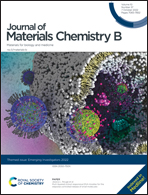Degradable silk-based soft actuators with magnetic responsiveness†
Abstract
Soft actuators with stimuli-responsiveness have great potential in biomedical applications such as drug delivery and minimally invasive surgery. In this study, protein-based soft actuators with magnetic actuation are fabricated using naturally occurring silk proteins and synthesized Fe3O4 magnetic nanoparticles (NPs). Briefly, magnetic silk films are first prepared by solution casting of a mixture containing silk proteins, synthesized Fe3O4 NPs, and glycerol. The molecular structures of the magnetic silk films are characterized by FTIR spectroscopy, which show that the β-sheet content in the films is about 20%. The mechanical tests show that the magnetic silk films can be stretched to over 200% under wet conditions and Young's modulus is estimated to be 4.89 ± 0.69 MPa, matching the stiffness of soft tissues. Furthermore, the enzymatic degradability, good biocompatibility, and in vivo X-ray visibility of the films are demonstrated by the in vitro enzymatic degradation test, in vivo biocompatibility test, and micro-CT imaging, respectively. Degradable silk-based soft actuators with magnetic responsiveness are successfully prepared by thermal forming or plastic molding of the magnetic silk films. The fabricated soft actuators can be actuated and move with precise locomotive gaits in solutions using a magnet. In addition, the retention of the soft actuators and localized drug delivery in gastrointestinal tracts by attaching a magnet to the abdominal skin are demonstrated using model systems. The degradable silk-based soft actuators provide many opportunities for improving current therapeutic strategies in biomedicine.

- This article is part of the themed collection: Journal of Materials Chemistry B Emerging Investigators


 Please wait while we load your content...
Please wait while we load your content...